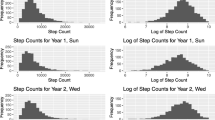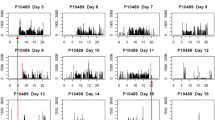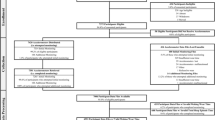Abstract
Missing data due to non-wear are common in accelerometer studies measuring physical activity and sedentary behavior. Accelerometer outputs are high-dimensional time-series data that are episodic and often highly skewed, presenting unique challenges for handling missing data. Common methods for missing accelerometry either are ad-hoc, require restrictive parametric assumptions, or do not appropriately impute bouts. This study developed a flexible hot-deck multiple imputation (MI; i.e., “replacing” missing data with observed values) procedure to handle missing accelerometry. For each missing segment of accelerometry, “donor pools” contained observed segments from either the same or different participants, and ten imputed segments were randomly drawn from the donor pool according to selection weights, where the donor pool and selection weight depended on variables associated with non-wear and/or accelerometer-based measures. A simulation study of 2550 women compared hot deck MI to two standard methods in the field: available case (AC) analysis (i.e., analyzing all observed accelerometry with no restriction on wear time or number of days) and complete case (CC) analysis (i.e., analyzing only participants that wore the accelerometer for ≥ 10 h for 4–7 days). This was repeated using accelerometry from the entire 24-h day and daytime (10am–8pm) only, and data were missing at random. For the entire 24-h day, MI produced less bias and better 95% confidence interval (CI) coverage than AC and CC. For the daytime only, MI produced less bias and better 95% CI coverage than AC; CC produced similar bias and 95% CI coverage, but longer 95% CIs than MI.







Similar content being viewed by others
References
Trost SG, Pate RR, Freedson PS, Sallis JF, Taylor WC (2000) Using objective physical activity measures with youth: how many days of monitoring are needed? Med Sci Sports Exerc 32(2):426–431
Evenson KR, Terry JW Jr (2009) Assessment of differing definitions of accelerometer nonwear time. Res Q Exerc Sport 80(2):355–362
Choi L, Liu Z, Matthews CE, Buchowski MS (2011) Validation of accelerometer wear and nonwear time classification algorithm. Med Sci Sports Exerc 43(2):357–364
Choi L, Ward SC, Schnelle JF, Buchowski MS (2012) Assessment of wear/nonwear time classification algorithms for triaxial accelerometer. Med Sci Sports Exerc 44(10):2009–2016
Little RJA, Rubin DB (2002) Statistical analysis with missing data, 2nd edn. Wiley, Hoboken, NJ
Rubin DB (1987) Multiple imputation for nonresponse in surveys. Wiley, New York
Schafer JL (1997) Analysis of incomplete multivariate data. Chapman & Hall, New York
van Buuren S (2007) Multiple imputation of discrete and continuous data by fully conditional specification. Stat Methods Med Res 16:219–242
Andridge RR, Little RJA (2010) A review of hot deck imputation for survey non-response. Int Stat Rev 78(1):40–64
Catellier DJ, Hannan PJ, Murray DM, Addy CL, Conway TL, Yang S, Rice JC (2005) Imputation of missing data when measuring physical activity by accelerometry. Med Sci Sports Exerc 37(11):S555–S562
Lee PH (2013) Data imputation for accelerometer-measured physical activity: the combined approach. Am J Clin Nutr 97:965–971
Lee JA, Gill J (2018) Missing value imputation for physical activity data measured by accelerometer. Stat Methods Med Res 27(2):490–506
LaCroix AZ, Rillamas-Sun E, Buchner D et al (2017) The objective physical activity and cardiovascular disease health in older women (OPACH) study. BMC Public Health 17:192
Anderson GL, Manson J, Wallace R et al (2003) Implementation of the Women’s Health Initiative study design. Ann Epidemiol 13:S5–S17
Hays J, Hunt JR, Hubbell FA, Anderson GL, Limacher M, Allen C, Rossouw JE (2003) The Women’s Health Initiative recruitment methods and results. Ann Epidemiol 13:S18–S77
Evenson KR, Wen F, Herring AH et al (2015) Calibrating physical activity intensity for hip-worn accelerometry in women age 60 to 91 years: the Women’s Health Initiative OPACH Calibration Study. Prev Med Rep 2:750–756
McHorney CA, Ware JE, Raczek AE (1993) The MOS 36-item Short-Form Health Survey (SF-36): II. Psychometric and clinical tests of validity in measuring physical and mental health constructs. Med Care 31:247–263
Ware JE, Sherbourne CD (1992) The MOS 36-item Short-Form Health Survey (SF-36): I. Conceptual framework and item selection. Med Care 30:473–483
Meyer AM, Evenson KR, Morimoto L, Siscovick D, White E (2009) Test-retest reliability of the WHI physical activity questionnaire. Med Sci Sports Exerc 41(3):530–538
Neuhouser ML, Di C, Tinker LF et al (2013) Physical activity assessment: biomarkers and self-report of activity-related energy expenditure in the WHI. Am J Epidemiol 177(6):576–585
LaMonte MJ, Lewis CE, Buchner DM, Evenson KR, Rillamas-Sun E, Di C, Lee I-M, Bellettiere J, Stefanick ML, Eaton CB, Howard BV, Bird C, LaCroix AZ (2017) Both light intensity and moderate-to-vigorous physical activity measured by accelerometry are favorably associated with cardiometabolic risk factors in older women: the Objective Physical Activity and Cardiovascular Health (OPACH) Study. J Am Heart Assoc 6:e007064
Little RJA (1988) A test of missing completely at random for multivariate data with missing values. J Am Stat Assoc 83(404):1198–1202
Acknowledgements
The authors would like to acknowledge the following investigators in the WHI Program: Program Office: (National Heart, Lung, and Blood Institute, Bethesda, Maryland) Jacques Rossouw, Shari Ludlam, Joan McGowan, Leslie Ford, and Nancy Geller. Clinical Coordinating Center: (Fred Hutchinson Cancer Research Center, Seattle, WA) Garnet Anderson, Ross Prentice, Andrea LaCroix, and Charles Kooperberg. Investigators and Academic Centers: (Brigham and Women’s Hospital, Harvard Medical School, Boston, MA) JoAnn E. Manson; (MedStar Health Research Institute/Howard University, Washington, DC) Barbara V. Howard; (Stanford Prevention Research Center, Stanford, CA) Marcia L. Stefanick; (The Ohio State University, Columbus, OH) Rebecca Jackson; (University of Arizona, Tucson/Phoenix, AZ) Cynthia A. Thomson; (University at Buffalo, Buffalo, NY) Jean Wactawski-Wende; (University of Florida, Gainesville/Jacksonville, FL) Marian Limacher; (University of Iowa, Iowa City/Davenport, IA) Jennifer Robinson; (University of Pittsburgh, Pittsburgh, PA) Lewis Kuller; (Wake Forest University School of Medicine, Winston-Salem, NC) Sally Shumaker; (University of Nevada, Reno, NV) Robert Brunner; (University of Minnesota, Minneapolis, MN) Karen L. Margolis. Women’s Health Initiative Memory Study: (Wake Forest University School of Medicine, Winston-Salem, NC) Mark Espeland.
The authors thank Fang Wen for her assistance with the data. This research was funded by grants from National Heart, Lung, and Blood Institute, National Institutes of Health (NIH), Grant R01HL105065 (PI: LaCroix) and contracts #HHSN268201100046C, #HHSN268201100001C, #HHSN268201100002C, #HHSN268201100003C, #HHSN268201100004C, and #HHSN271201100004C. The WHI program is funded by the National Heart, Lung, and Blood Institute, NIH, through contracts #HHSN268201600018C, #HHSN268201600001C, #HHSN268201600002C, #HHSN268201600003C, and #HHSN268201600004C. The content is solely the responsibility of the authors and does not necessarily represent the views of the NIH. The results of the present study do not constitute endorsement by the authors of the products described in this paper. The results of this study are presented clearly, honestly, and without fabrication, falsification, or inappropriate data manipulation.
Author information
Authors and Affiliations
Corresponding author
Ethics declarations
Ethical Approval
All procedures performed in studies involving human participants were in accordance with the ethical standards of the institutional and/or national research committee and with the 1964 Helsinki declaration and its later amendments or comparable ethical standards.
Electronic supplementary material
Below is the link to the electronic supplementary material.
Rights and permissions
About this article
Cite this article
Butera, N.M., Li, S., Evenson, K.R. et al. Hot Deck Multiple Imputation for Handling Missing Accelerometer Data. Stat Biosci 11, 422–448 (2019). https://doi.org/10.1007/s12561-018-9225-4
Received:
Revised:
Accepted:
Published:
Issue Date:
DOI: https://doi.org/10.1007/s12561-018-9225-4




